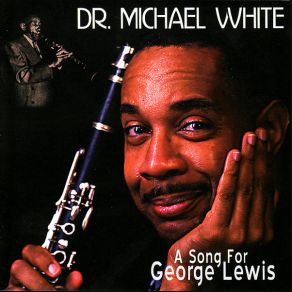A Song for George Lewis
Download links and information about A Song for George Lewis by Dr. Michael White. This album was released in 2000 and it belongs to Jazz genres. It contains 13 tracks with total duration of 01:12:52 minutes.

|
|
|---|---|
| Artist: | Dr. Michael White |
| Release date: | 2000 |
| Genre: | Jazz |
| Tracks: | 13 |
| Duration: | 01:12:52 |
| Buy it NOW at: | |
| Buy on iTunes $7.99 | |
| Buy on Amazon $8.99 | |
Tracks
[Edit]| No. | Title | Length |
|---|---|---|
| 1. | Big Chief Battle Axe | 3:41 |
| 2. | Louisian-i-a | 6:49 |
| 3. | Burgundy Street Blues | 4:19 |
| 4. | Bugle Boy March | 6:33 |
| 5. | A Song for George Lewis | 5:05 |
| 6. | St. Phillip Street Breakdown | 5:02 |
| 7. | Just a Closer Walk With Thee | 10:47 |
| 8. | One Sweet Letter from You | 4:19 |
| 9. | Over the Waves | 4:26 |
| 10. | Stafford Strut | 3:52 |
| 11. | What a Friend We Have In Jesus | 7:44 |
| 12. | Indiana Sagua | 2:25 |
| 13. | Just a Little While to Stay Here | 7:50 |
Details
[Edit]Prior to this recording, jazz historian, educator, and clarinetist Michael White had studied under and performed for many years around the world with contemporaries of clarinetist George Lewis — a central figure of the New Orleans revival of the '50s — and A Song for George Lewis serves as a centennial celebration of the birth of the Crescent City jazz legend. The set is worthy of its inspiration and, generally speaking, is high-quality authentic, traditional, New Orleans-style jazz. It is an album overflowing with vibrant color and one that evokes a variety of moods. White selected a baker's dozen of songs —marches, hymns, blues, pop songs — many of them popularized by or staples in the repertoire of the various aggregates led by Lewis, including numerous classic New Orleans tunes, a few spirituals, and a couple compositions by Lewis himself, including his charming "Burgundy Street Blues," a signature tune of sorts. In addition, Dr. White throws in a couple of his own originals —including the title cut march —which fits seamlessly in the album's flow. The music is rollicking exuberance at times ("Bugle Boy March"), mournful at others ("Just a Closer Walk with Thee"), and often a finger-snapping party ("St. Phillip Street Breakdown," "One Sweet Letter from You"), but the music is, on the whole, accomplished. White's solos are consistently marvelous, and he assembled a crack ensemble around him, a mixture of young and more established players who work off their sources of inspiration without mimicking them. It is certainly not modern jazz by any stretch of the imagination, often being relegated to New Orleans parades and funerals. But the recording is so evocative of the city and expressive of such a broad range of emotions that it could serve as a worthwhile introduction to jazz's early legacy. And it would have certainly made George Lewis proud.